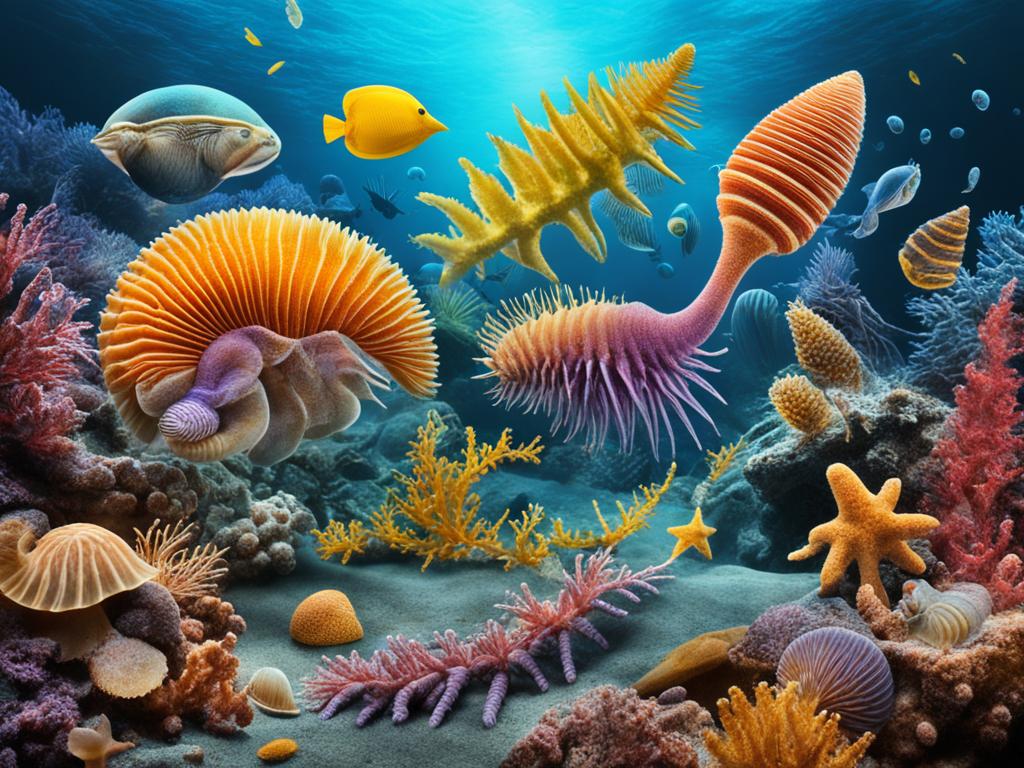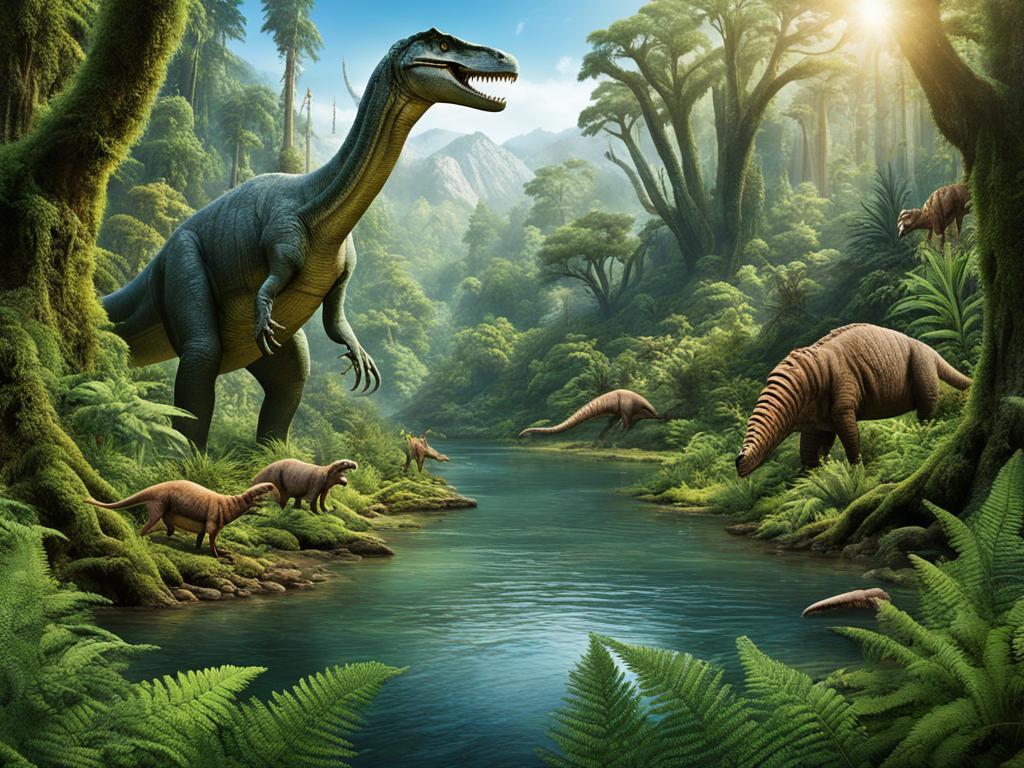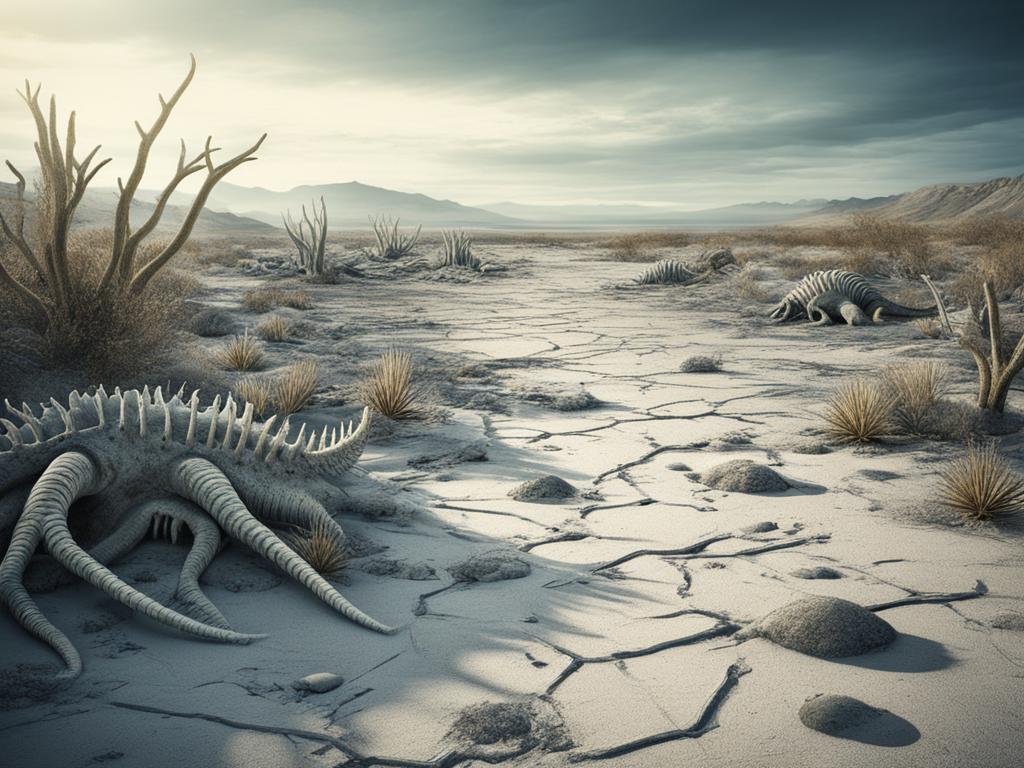The Geologic Time Scale tells the story of Earth in four main parts: Precambrian, Paleozoic, Mesozoic, and Cenozoic Eras. Each era is unique. We see different species come and go. These changes over time help us understand Earth’s history.
The Precambrian Era stands out because it stretches far back in time, before there was lots of different life. It lays the groundwork for life to fill the planet. The Paleozoic Era starts with the Cambrian Explosion. This was a time when life on Earth began to quickly diversify.
The Mesozoic Era is often called the “age of the dinosaurs.” It was when dinosaurs ruled. The Cenozoic Era came after. It’s known as the “age of mammals,” which is the period we find ourselves in today.
Key Takeaways
- The Geologic Time Scale divides Earth’s history into four major eras: Precambrian, Paleozoic, Mesozoic, and Cenozoic.
- The Paleozoic Era began with the Cambrian Explosion, a rapid period of speciation that led to a flourishing of life on Earth.
- The Mesozoic Era is known as the “age of the dinosaurs” due to their dominance during this time.
- The Cenozoic Era is sometimes called the “age of mammals” and is the era in which we currently live.
- Precambrian Time, while not an actual era, is still considered significant as it predates the other three eras and may provide insights into the origins of life on Earth.
The Geologic Time Scale: Earth’s Chronological History
The geological time scale highlights our scientific journey in geology. It helps compare rocks and fossils worldwide. We mark time on this scale with the appearance or loss of certain fossils. This is key for figuring out how old rocks are.
Defining Epochs, Periods, and Eras
Our geologic time scale is split into Eons, Eras, Periods, and Epochs. Eons stand for the longest periods of time and are defined by the presence of certain fossils. Eras come next and are about big changes in life on Earth. Periods are named after the types of life that were common during these times. And Epochs, the shortest times, show variations in life that could be global or local.
Principles of Relative Age Dating
William Smith introduced the idea that different fossils tell us about different times. This is known as the principle of faunal succession. It’s because life on Earth has changed over time. He also taught us how to read rocks through principles like superposition and lateral continuity.
Temporal Correlation and Fossil Records
Geologists use the power of fossils to compare rocks in far-flung places. This lets them piece together Earth’s deep history. The fossil record is our best view into the past. It shows us how life has evolved and survived major changes in our planet.
The Precambrian Eons: Earth’s Earliest History
Earth’s history is divided into four eons. The Hadean, Archean, and Proterozoic eons are known together as the “Precambrian.” These eons cover 88% of Earth’s past. The rest, which includes the Paleozoic, Mesozoic, and Cenozoic eras, is the Phanerozoic eon. This is a smaller part of Earth’s time. The first three eons are challenging to study because we see so little of their surface. The Proterozoic eon lasted for almost 2 billion years. It’s easier to study but hasn’t gotten a lot of attention from scientists until recently.
The Hadean and Archean Eons
The Hadean, Archean, and Proterozoic Eons are the earliest times on Earth’s clock. They are part of the Precambrian Eon. The Phanerozoic Eon came later. Rocks from the Precambrian tell us about early, simple life. This life dates back about 3.5 billion years.
The Proterozoic Eon and the Rise of Complex Life
The Proterozoic eon lasted for almost 2 billion years. It occupies 42% of Earth’s past. This time marked the beginning of complex life. Single-celled organisms started to appear. Over time, oxygen built up in the air. The Riphean rocks were laid down in warm seas from 1.65 billion to 800 million years ago. In India’s Aravalli mountains, large deposits of phosphorite are found. These are from the Proterozoic Eon and have many stromatolites.
The Paleozoic Era: The Age of Invertebrates and Early Vertebrates
The Paleozoic Era started with the Cambrian Explosion, a time when life bloomed in the oceans. This was the first era where tons of life started moving onto the land. Plants were the first ones to try it, followed by invertebrates, who were animals without backbones. After them came the vertebrates, the group that includes us, humans. This era lasted about 300 million years, from 542 million years ago to 251 million years ago, taking up over half of a super long time called the Phanerozoic eon.
The Paleozoic Era is split into six parts: Cambrian, Ordovician, Silurian, Devonian, Carboniferous, and Permian. They’re named after where scientists first checked out the rocks from those times. The Cambrian period started with a bang, about 538.8 million years back. That’s when over 35 new groups of animals showed up, a time we call the Cambrian Explosion. Things kept getting more varied in the Cambrian and Ordovician times. Creatures started to get hard shells and exoskeletons during the Cambrian, like trilobites and crinoids.
The end of the Paleozoic Era had a real tough time, known as the Permian extinction. It was so bad that 95% of ocean invertebrate species died, and almost 70% of land life went away. This event was about 251.4 million years ago and was really hard on ocean life. Many kinds of animals vanished forever, like tabulate and rugose corals, blastoid echinoderms, graptolites, trilobites, and most crinoids.
| Paleozoic Period | Duration (mya) | Significant Events |
|---|---|---|
| Cambrian | 541 – 485 | Cambrian explosion, evolution of invertebrates, emergence of protective shells and exoskeletons |
| Ordovician | 485 – 444 | Transition of life from seas to land, mass extinction event |
| Silurian | 444 – 419 | Appearance of first fish with jaws |
| Devonian | 419 – 359 | Evolution of first amphibian-like animals, emergence of first trees and seed-producing plants |
| Carboniferous | 359 – 299 | Formation of coal deposits, rise of amphibians |
| Permian | 299 – 252 | Permian extinction, the largest mass extinction event in Earth’s history |
All through the Paleozoic Era, Paleozoic rocks spread out everywhere. They have cool creatures in them, like trilobites, graptolites, conodonts, ammonoids, and fusulinids. These are really helpful for figuring out the different times in this long era. A few big extinction events happened too, at the end of the Ordovician and Devonian periods. They shaped how life moved forward on Earth during this era.
Major Geological Eras: From Precambrian to the Present
Cambrian Explosion and Trilobite Dominance
The Paleozoic Era kicked off with a bang during the Cambrian Explosion. It was a time when many new types of creatures started to appear. Trilobites, a kind of ancient sea animal, were at the top of the food chain in the sea then.
Ordovician and Silurian: The Age of Fishes
The next Eras, the Ordovician and Silurian, became known as the “age of fishes”. This is when we first see fishes swimming around oceans. Over time, fishes became very successful, ruling the waters.
Devonian: The Emergence of Land Plants and Amphibians
The Devonian Era was groundbreaking for life on Earth. It’s when land plants and amphibians appeared. These made it possible for life to move from water onto land. Meanwhile, fish still flourished in the oceans.

The Carboniferous and Permian Periods: The Age of Amphibians
The Carboniferous and Permian Periods are known as the “age of amphibians.” They were a big part of our planet’s geological history. The Carboniferous Period, between 359 million years ago and 299 million years ago, saw huge tropical swamps in North America, Europe, and Siberia. These swamps created large coal deposits, which powered the Industrial Revolution later on.
As the Paleozoic Era ended, continents came together to form Pangaea. This big movement, along with changing climates, caused the biggest extinction event on Earth. Known as the Great Paleozoic Extinction, it killed 95% of sea life and almost 70% of land animals. This marked the end of the “age of amphibians” and started the Mesozoic Era, known as the “age of reptiles.”
The exact cause of the Great Paleozoic Extinction is still debated. The top theory says Pangaea’s formation changed climates, causing a chain reaction. These changes likely disrupted the balance that kept Paleozoic life forms alive.
The Carboniferous and Permian Periods left a unique mark on Earth. They tell us about life’s evolution and warn us about large environmental changes. It’s a reminder of how fragile life on Earth can be.
The Mesozoic Era: The Age of Reptiles
After the Paleozoic Extinction, many new species emerged during the Mesozoic Era. It’s also known as the “age of the dinosaurs.” This period lasted from 252.2 million years ago to 66 million years ago. It’s famous for the Mesozoic Era.
Triassic: The Rise of Dinosaurs
The Triassic Period, lasting from 252 million years ago to 201 million years ago, was ruled by dinosaurs. North America’s rocks were mainly red sandstones and mudstones. These rocks show how dinosaurs rose to power.
Jurassic: The Reign of Dinosaurs
During the Jurassic Period, from 201 million years ago to 145 million years ago, dinosaurs ruled. Birds also first appeared, and the Atlantic Ocean formed. This was because the continents were shifting apart.
Cretaceous: The End of the Dinosaurs
The Cretaceous Period, from 145 million years ago to 66 million years ago, was the “age of reptiles.” Dinosaurs and the first flowering plants lived during this time. A massive extinction event ended the dinosaur era.

The Cenozoic Era: The Age of Mammals
The Cenozoic Era is the last era we know of. It started after the large dinosaurs died out. This period let the smaller mammals, who had survived, grow and take over. The climate changed a lot, becoming cooler than before. An ice age also spread over much of the Earth. This made life change quickly to survive, pushing evolution to go faster.
Paleogene: Recovery After the K-T Extinction
The Paleogene Period happened from 66 million to 23 million years ago. Life was recovering after a big event that wiped out the dinosaurs. During this time, mammals started to rule the land. They took over the spaces the dinosaurs left behind.
Neogene and Quaternary: The Emergence of Humans
The Neogene and Quaternary periods followed. They happened after the Paleogene. Mammals kept evolving and spreading out. Eventually, humans came to dominate the Earth. The climate changed a lot during this time. Major glaciations affected the Northern Hemisphere and life on the planet hugely.
Over the Cenozoic Era, every life form, including us humans, evolved. This era hasn’t ended. It likely won’t until there’s another big extinction.
Continental Drift and Plate Tectonics
The Earth’s surface and landscape have changed a lot because of Continental Drift and Plate Tectonics. These processes have been happening for a long time. About 200 million years ago, these movements started with the supercontinent Pangaea. Since then, the continents have moved apart to their current positions.
Pangaea and the Breakup of Continents
Around 200 million years ago, Pangaea started to break apart. The Atlantic plate moved over the Pacific plate. This movement made the western mountains. It also caused the formation of the Rocky Mountains through igneous activity.
The Pacific plate was pushed under some of the other plates, which helped build mountains too. This process caused more volcanic eruptions and igneous activity in the area.
Mountain Building and Igneous Activity
When continental and oceanic plates come together, mountains form. This compression and uplift make areas like the Himalayas, the Andes, and the Rocky Mountains. Mountain building is often linked with a lot of igneous activity.
This igneous activity includes volcanic eruptions and magma getting into Earth’s crust. It has been an essential part of how the Earth looks now.
Mass Extinctions and Fossil Records
Throughout Earth’s history, there have been several major mass extinctions. These events have hugely impacted life on our planet. The end-Permian and end-Cretaceous extinctions stand out. They wiped out 90% and 25% of species, respectively. Debated causes include climate change, volcanic activity, and meteor strikes.
Major Extinction Events and Their Causes
The “Great Dying” happened around 290 million years ago during the Permian mass extinction. This event was likely triggered by massive volcanic activity in Siberia. It changed the atmosphere, global temperatures, and ocean chemistry. This led to the loss of nearly 95% of marine life. It also affected about 70% of land species.
The end-Cretaceous extinction is linked to a huge meteor impact. This event led to quick climate changes and the end of the dinosaurs. It killed off many marine species as well.
Fossil Preservation and Paleontological Significance
The fossil record is key in understanding mass extinctions and life’s evolution. Yet, it’s not a perfect record. The way fossils are preserved is complex. It depends on many factors like geological events, the environment, and the organisms themselves. Scientists must be aware of these factors when using the fossil record to study life’s history on Earth.

Studying mass extinctions and fossils goes beyond science. It helps teach students about Earth’s geological past. In South Carolina, for instance, fossil analysis is a big part of the educational standards. It shows how Earth’s dynamic processes shaped life over time. Paleontologists use this data to understand the basic principles of evolution. They also look into how life has adapted to big environmental changes.
Geologic Time Scale: A Scientific Achievement
The Geologic Time Scale stands out as a top achievement in science. It sums up a massive amount of data to give us a picture of Earth’s history. This is done using detailed observations of fossils in rock layers. These help geologists and paleontologists understand our planet’s past and find important resources. For anyone studying the Earth’s history, learning about the Geologic Time Scale is crucial.
The Geologic Time Scale is a big deal in science. It shows us a timeline of Earth’s past by looking at layers of rock and their fossils. Thanks to this work, we know more about our planet and can find useful resources. The Geologic Time Scale has changed how we see Earth’s history and its value today.
Exploring the Geologic Past: Challenges and Opportunities
We have made big steps in getting to know the Geologic Past. Yet, there are still many things to explore. Thanks to new techniques, we can now date geological events more precisely. This helps us figure out the ages of rocks and the key moments in Earth’s history.
Integrating Geological and Biological Perspectives
Mixing geological and biological perspectives offers a broader view. It helps us understand how Earth and life developed together. By studying rocks and fossils together, we learn more about the deep connections between Earth’s past and the history of life.
Uncovering the Mysteries of the Precambrian
The Precambrian eons are very old and full of mysteries. They cover most of Earth’s history before complex life appeared. Scientists are eager to learn how life started and how our planet formed. This period is crucial. It tells us how simple life forms transformed into the rich variety of life we know now. As we keep digging into the past, we’re piecing together the story of Earth and all its life.
Source Links
- https://www.thoughtco.com/eras-of-the-geologic-time-scale-1224551
- https://www.digitalatlasofancientlife.org/learn/geological-time/geological-time-scale/
- https://www.dnr.sc.gov/geology/pdfs/education/Geologic Time.pdf
- https://www.britannica.com/science/Precambrian
- https://www.britannica.com/science/Paleozoic-Era
- https://ucmp.berkeley.edu/paleozoic/paleozoic.php
- https://www.usgs.gov/youth-and-education-in-science/paleozoic
- https://kids.britannica.com/kids/article/geologic-time/390244
- http://hyperphysics.phy-astr.gsu.edu/hbase/Geophys/geotime.html
- https://www.britannica.com/science/Carboniferous-Period
- https://geokansas.ku.edu/paleozoic-era-541-million-years-ago-to-252-million-years-ago
- https://www.britannica.com/science/Mesozoic-Era
- https://www.britannica.com/science/Cenozoic-Era
- https://www.britannica.com/science/plate-tectonics/Plate-tectonics-and-the-geologic-past
- https://en.wikipedia.org/wiki/Geological_history_of_Earth
- https://www.nps.gov/subjects/geology/time-scale.htm
- https://opengeology.org/textbook/7-geologic-time/


